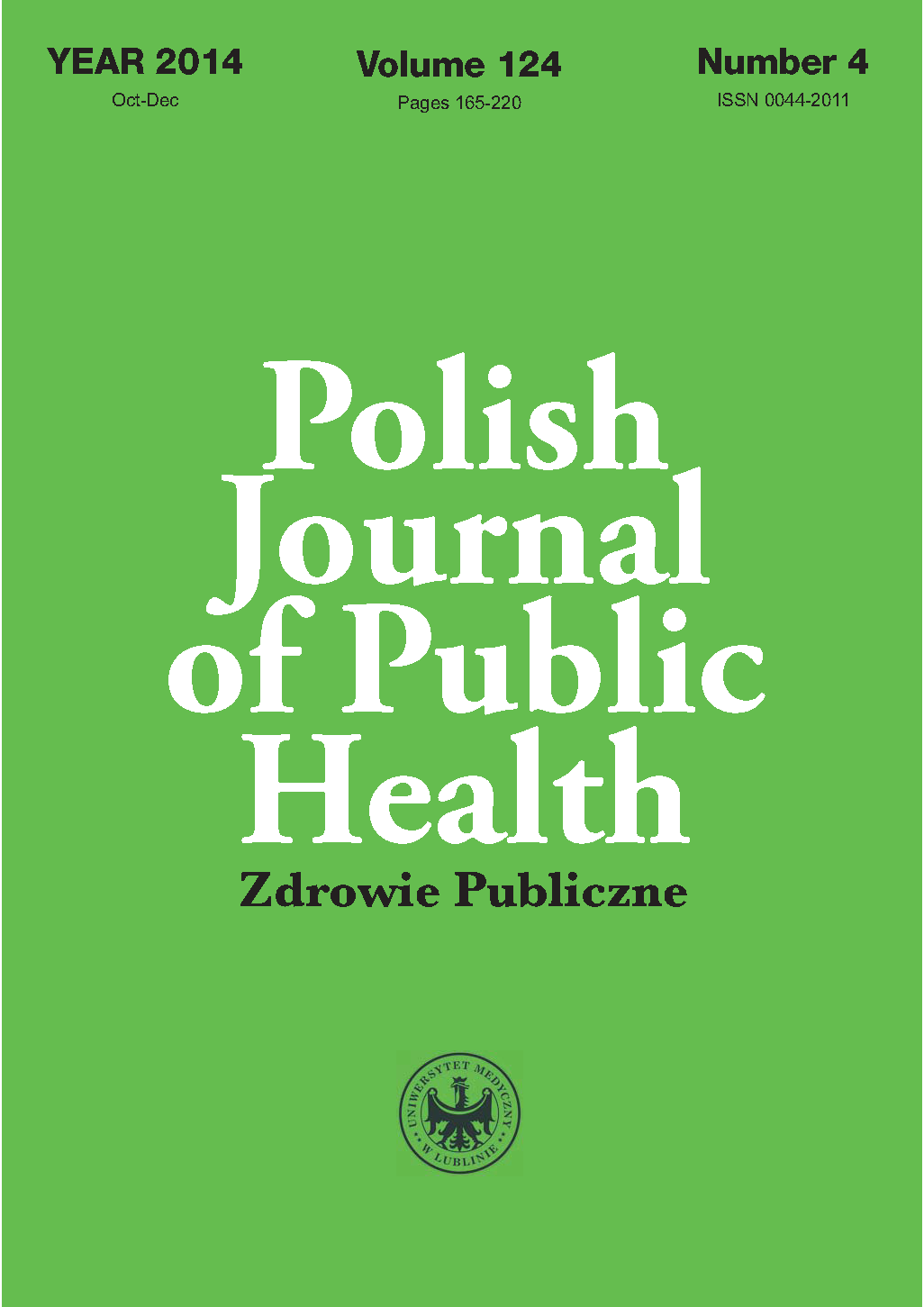Vaccinations of children against chickenpox and pneumococcal infection on the example of several family practice physicians’ settings
DOI:
https://doi.org/10.1515/pjph-2015-0008Keywords:
vaccinations, children, chickenpox, pneumococcal infectionAbstract
Introduction. Vaccinations against varicella and pneumococcal infection are an important form of prevention of infectious diseases and their possible complications.
Aim. Assessment of the vaccination control of children against varicella, and pneumococcal infection based on selected institutions of family practice physician.
Material and methods. There were verified 807 immunization cards of children from three vaccination offices, selected at random from the area of the southeastern Poland, i.e. the provinces of Lubelskie, Podkarpackie and Świętokrzyskie. Based on the results of quantitative analysis of medical records of vaccination carried out in these institutions through 2007-2012, the number of children vaccinated against varicella, and pneumococcal infection was assessed.
Results. The largest number of vaccinated children (against pneumococcal infection – 148 children and 84 against varicella among 335 subjects reporting in the facility) was confirmed in health care unit in Lublin. In health care unit in Podkarpackie the number of vaccinated children against pneumococcal infection was 84 and against chicken pox – 52 among 256 children using the medical services. In health care unit in Świętokrzyskie, 65 children were vaccinated against pneumococcal infection and 34 against varicella among 216 subjects reporting at the institution. The vast majority of these vaccines (431 – including three centers) was paid by parents.
Conclusions. 1. In all of the centers, a higher proportion of children was vaccinated against pneumococcal infection than chickenpox. 2. There was not a marked increase in the number of children vaccinated against varicella and pneumococcal infection during the analyzed period.
References
1. Czajka H, Wysocki J. Szczepienia w profilaktyce chorób zakaźnych. Kraków: Help Med; 2010.
2. Rudkowski Z. Szczepienie przeciwko ospie wietrznej – systematyczny przegląd aktualnej wiedzy. Med Prakt Pediatr. 2002;3:11-25.
3. Duszczyk E, Marczyńska N, Talarek E. Ospa wietrzna – czy jest groźną chorobą? Zakażenia. 2009;1:63-7.
4. Zalecenia zespołu ekspertów dotyczące stosowania dwudawkowego schematu szczepień przeciwko ospie wietrznej. Med Prakt Supl Szczepienia. 2010;2:4-11.
5. Korona-Głowniak I, Malm A. Szczepienia przeciwko zakażeniom pneumokokowym – korzyści dla zdrowia publicznego. Zdr Publ. 2010;120(3):306-10.
6. Pokorna-Kałwiak D, Mastalerz-Migas A. Szczepienia zalecane w praktyce lekarza rodzinnego. Terapia. 2010;4:63-8.
7. Patrzałek M, Albrecht P, Sobczyński M. Pośredni, populacyjny wpływ powszechnych szczepień skoniugowaną szczepionką pneumokokową (PCV7) na częstość zachorowań na zapalenie płuc w Kielcach. Przeg Epidemiol. 2011;65:51-6.
8. Gowin E, Wysocki J. Pneumococci – it’s never too late for vaccination – case report. Przeg Pediatr. 2011;3:121-3.
9. Use of 13-valent pneumococcal conjugate vaccine and 23-valent pneumococcal polysaccharide vaccine for adults with immunocompromising conditions: recommendations of the Advisory Committee on Immunization Practices (ACIP). MMWR. 2013;62:521-4.
10. Jankowska-Folusiak J. Powikłania ospy wietrznej u dzieci. Przeg Pediatr. 2011;2:86-9.
11. Pilishvili T, Lexau C, Farley MM, et al. Sustained reductions in invasive pneumococcal disease in the era of conjugate vaccine. J Infect Dis. 2010;201:32-41.
12. Skoczyńska A, Sadowy E, Bojarska K, et al. The current status of invasive pneumococcal disease in Poland. Vaccine. 2011;29:2199-205.
13. Gershon AA. Live-attenuated varicella vaccine. Infect Dis Clin North Am. 2001;15:65-81.
14. Liese JG, Grote V, Rosenfeld E, et al. The burden of varicella compications bevor the introdiuction of foutine varicella vaccination in Germany. Pediatr Infect Dis J. 2008;27(2):119-24.
15. Bozzola E, Tozzi AE, Bozzola M, et al. Neurological complications of varicella in childhood: case series and a systematic review of the literature. Vaccine. 2012;30:5785-90.
16. Narodowy Instytut Zdrowia Publicznego, Państwowy Zakład Higieny, Zakład Epidemiologii Główny Inspektorat Sanitarny, Departament Zapobiegania i Zwalczania Zakażeń i Chorób Zakaźnych u Ludzi. Szczepienia ochronne w Polsce w 2012 roku (podstawowe tablice robocze – wstępne dane) 15.06.2013 r.
17. Szczawińska-Popłonyk A, Bręborowicz A. Szczepienia ochronne w profilaktyce zakażeń układu oddechowego u dzieci. Terapia. 2012;2:18-26.
18. Jackson LA, Neuzil KM. Pneumococcal polysaccharide vaccines, w: Vaccines, Plotkin S, Orenstein W, Offit P. Fifth Edition 2008.
19. Endrich M, Blank P, Szucs T. Influenza vaccination uptake and socioeconomic determinants in 11 European countries. Vaccine. 2009;27:4018-24.
20. Bernatowska E, Pac M. Fakty o mitach – czy szczepionki są bezpieczne. Standardy Med Pediatr. 2011;8:711-8.


